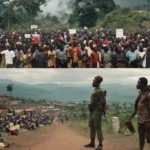Joe
The crisis in Cameroon, often referred to as the Anglophone Crisis, is a complex and ongoing conflict that has its roots in the country’s colonial past and linguistic divisions. Here’s a brief overview:
1. Historical Background: Cameroon was colonized by both the French and the British, leading to a bilingual nation with French-speaking (Francophone) and English-speaking (Anglophone) regions. After gaining independence, the predominantly Francophone government has allegedly marginalized the Anglophone regions, which are in the Northwest and Southwest.
2. Escalation: In 2016, peaceful protests erupted in the Anglophone regions, initially sparked by demands for better representation and the use of English in courts and schools. The government’s repressive response to these protests escalated tensions, leading to demands for independence by some groups and, ultimately, an armed conflict.
3. Humanitarian Impact: The crisis has resulted in significant human rights violations, including violence against civilians, displacement of thousands of people, and restrictions on humanitarian access. Both government forces and armed separatists have been accused of committing atrocities.
4. Current Situation: The conflict continues, with efforts for dialogue and peace remaining largely ineffective. The government’s attempts to grant the Anglophone regions “Special Status” have not yet resolved the underlying issues.
5. International Attention: Organizations such as Amnesty International and Crisis Group have been monitoring the situation, calling for both national and international efforts to address the humanitarian needs and find a sustainable political solution.
The situation remains fragile, with ongoing efforts needed to bring about peace and stability in the region. If you want to know more about specific aspects of the crisis, feel free to ask!
Author: Joe Najeme




